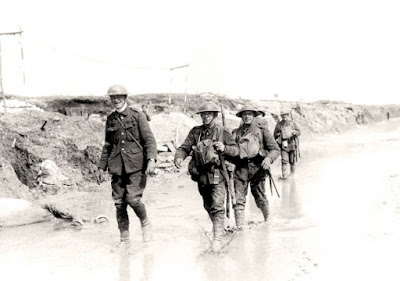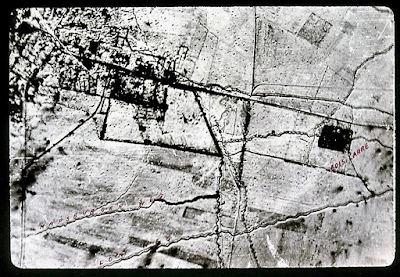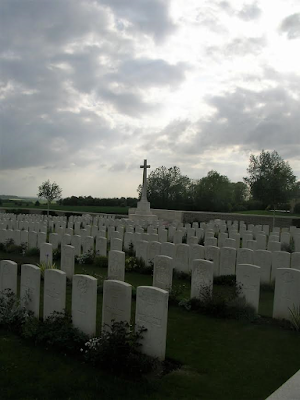This week, starting on Sunday, marks the centenary of the Battle of Vimy Ridge, when the Canadian Corps, fighting together, achieved a significant victory on the Western Front during World War One. Vimy is often regarded as part of Canada’s coming of age as a post-colonial country, as this backgrounder in the New York Times explains.
Canadian historian Duff Crerar, an authority on Canadian chaplains in the Great War, has been regaling his friends with stories of how our padre ancestors supported the Vimy battle. I have collected his emails and images below and am happy to present them. MP+
Preparing for the Battle – 1
The First Canadian Division moved into its pre-Vimy quarters
around the old Chateau of Ecoivres in mid-March. In the upstairs hall rested a
large model of Vimy Ridge, which officers and men came through to study. In the
garden was a billet filled up with tall racks of bunk beds, packing in almost
1500 men, with a high platform at one end, from which Canon Scott gave nightly
lectures after the band played a brief concert. To keep morale up, he
encouraged written questions to be handed up to him which he would try to
answer in an uplifting way. The first night everyone had a good laugh at
Scott’s expense when the note was read aloud without previewing or censorship:
“When do you think this God dam war will be over, eh?” On April 4 the news came
the America had joined the Allies, which partially answered the question that
stumped him a few nights before.
trenches and headquarters, he often donned a private’s uniform, but still was
easily identified by his white hair and clerical collar. All around him he
noted the stacks of ammunition accumulating, pitying the horses which dragged
heavy loads until some died of exhaustion. At night the road to Arriane Dump
and the narrow plank road connecting it with the St. Eloi road was crowded with
trucks, wagons, limbers, horses and men crowding each other in the blackout and
often forcing each other off into the deep mud on either side. Through the
tumult and furious cursing in the darkness the Senior Chaplain would make his
way, joking that the horses and mules, at least, could not understand the
profanity directed at them.
shrine with canvas over the windows, which he dubbed “St. George’s Chapel”.
Each morning at 0800 he celebrated Holy Communion, with the troops standing in
and around the altar. Underneath a shell-battered crossroads named Maison
Blanche, a large cavern sheltered one of the battalions in reserve, where Scott
would drop in to hold services. Scott was famous for breaking up gambling when
he encountered it, but one night men of the 16th, holding hot cards,
promised to come if he let them finish their hand. After announcing that he
would hold the service until the game was over, almost everyone there joined
the service.
occasionally let loose, carefully seeking out their future targets, and
startling bystanders not aware of their well-camouflaged hideouts. But enemy
fire could still strike the best-concealed by chance. Canadian Railway troops
died when a German shell hit their billets. Scott buried eleven of them on the
hillside.
From the Report of Major A.M. Gordon, Sr. Chaplain, 4th
Canadian Division dated 17 March, 1917
worship parades in 4th Division. During the trench raids in
preparation for the main attack all his chaplains have been either in battalion
Headquarters or Advanced Dressing Stations. Other chaplains maintained Chaplain
Service coffee stalls where hot drinks were dished out to the men going forward
or coming out of action. During the raid on 15 March, Chaplain George Farquhar
served at the Regimental Aid Post with the Medical Officer, at the request of
both the battalion commander and the M.O.
Quartermaster General, Canadian Corps, requesting sites for Chaplain Service
Coffee Stalls directly on the routes to be taken by the troops of 4. Canadian
Division during the Vimy Attack, in areas relatively safe from shelling.
(Report by Major the Rev. A.M. Gordon, 4 Div. Sr. Chaplain)
-
3 Protestant chaplains at the RAPs, 1 Protestant
at the Advanced Dressing Station on the Arras Road, 2 Roman Catholic chaplains
at relay point for ambulances and stretcher bearers, Two Protestant chaplains
at the Main Dressing Station # 11 Canadian Field Ambulance, with two Roman
Catholic chaplains alternating duty there for round the clock coverage. One
Protestant chaplain will cover the #12 Field Ambulance, while one will serve as
spare for coffee stall, burial party and battalion coverage. Gordon leaves his
most junior chaplain in the office and goes forward to supervise and assist in
the 4th Divisional front line area.
The Chaplains of the 2nd Division left extensive reports which can be matched with contemporary trench maps and aerial photographs to demonstrate how they followed the attacking troops, setting up aid posts and working with casualties in captured dugouts and trenches. D.E. Robertson’s report begins with jumping off with the second wave of attackers, accompanying medical officers and others setting up advanced posts on the far side of Thelus. From 1400 onwards Robertson and a Medical sergeant operated an advanced aid post in a dugout in Bois Carre, which treated men coming in from many battalions, and many wounded Germans as well. Robertson scrounged rations and a German camp stove and was able to provide hot and cold drinks to the wounded and the stretcher bearers. He stayed on in the dugout through the next few days “During all the time, I tried to speak a word of comfort or offer a prayer with the wounded. I took the names of home folks, and any messages they wished me to send. This meant writing scores of letters. Near Bois Carre I established a cemetery primarily for the 4th battalion, It has been recognized by the Graves Registration Commission. I buried twenty six men belong to the 14 and 31st Battalions, and of the Trench Mortar Battery. On the night of the 12th we moved back to the old German front line. “ The return was complicated by he and eight others taking turns bringing back a wounded German they had found in the bottom of a trench, nearly frozen The mud was so deep that it took several hours to get the man under shelter. Looking back, he noted that every soldier he had personally greeted the night before the attack had either been killed or had passed by him, smiling but wounded, going the other way after the battle.





A moving post.
Very moving indeed